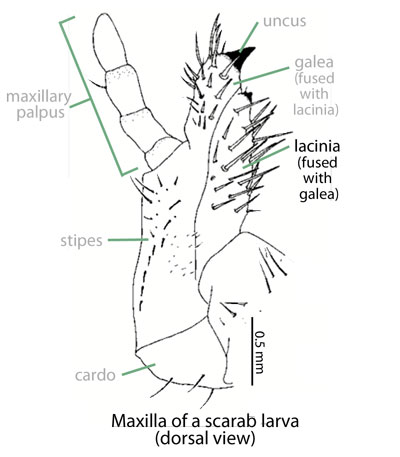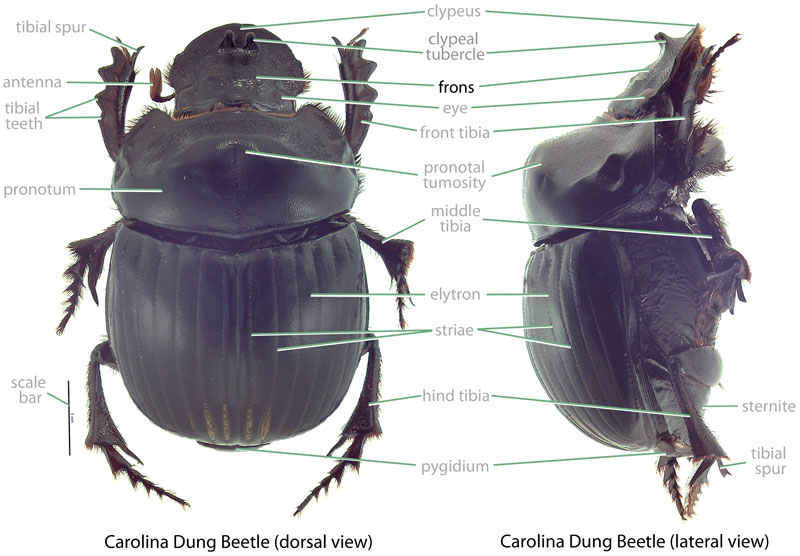Pest
none known
Family: Scarabaeidae Subfamily: Rutelinae Genus: Popillia Species: Popillia lewisi Arrow, 1913
none available
Total body length 8.4–10.3 mm (0.33–0.41 in). Body oval-shaped. Color shining green, sometimes with reddish sheen; elytraelytra:
the hardened and chitinous wing-cover of a beetle that protect and overlie the flight wing
shiny tan to brown. Clypeusclypeus:
part of the head anterior to the frons; the most anterior portion in dorsal view
 rounded with apexapex:
rounded with apexapex:
point or edge furthest from the body
somewhat recurvedrecurved:
bending backwards
; narrowed toward apexapex:
point or edge furthest from the body
. Front claw toothed, male with toothed claw more robust than in female. Pronotumpronotum:
the dorsal surface of the thorax
 with sparse punctationpunctation:
with sparse punctationpunctation:
relating to a punctate surface texture
near anterioranterior:
the front or forward; opposite of posterior
border; punctures small, indistinct. Pygidiumpygidium:
the last abdominal segment, usually exposed, not completely covered by the elytra
 with 2 crescent-shaped patches formed by dense, whitish setaesetae:
with 2 crescent-shaped patches formed by dense, whitish setaesetae:
small, hair-like structure
(setae often lost in older specimens).
Undescribed. For Popillia spp. (Ritcher, 1966Ritcher, 1966:
Ritcher P. 1966. White grubs and their allies: a study of North American scarabaeoid larvae. Oregon State University Monographs, Studies in Entomology 4: 1-219.): Grub C-shaped, not hump-backed, cylindrical, whitish. Maxillamaxilla:
set of paired mouthparts located posterior to the mandibles
with galeagalea:
outer branch or lobe of the maxilla
 and lacinialacinia:
and lacinialacinia:
inner portion of the maxilla fused or nearly so. Fronsfrons:
fused or nearly so. Fronsfrons:
part of the head generally positioned between the eyes (posterior to the clypeus and anterior to the vertex) and visible dorsally
 sparsely punctatepunctate:
sparsely punctatepunctate:
a surface texture characterized by numerous puncture-like marks or impressions, often described in terms of puncture size, shape, and density
. Labrumlabrum:
upper lip that covers the mandibles and is located ventrally relative to the clypeus
 asymmetrical. Claws sharply pointed. Spiraclesspiracles:
asymmetrical. Claws sharply pointed. Spiraclesspiracles:
opening on the abdomen or thorax through which air enters and exits the body
 on 7th and 8th abdominal segments nearly equal in size. Dorsa of 9th and 10th abdominal segments not fused. Septulaseptula:
on 7th and 8th abdominal segments nearly equal in size. Dorsa of 9th and 10th abdominal segments not fused. Septulaseptula:
narrow bare area(s) of raster
shaped like an equilateral triangle, palidiapalidia:
paired group(s) of recumbent (reclining) spines, usually occurring in rows; part of the raster
strongly diverging posteriorly; each palidiumpalidium:
paired group(s) of recumbent (reclining) spines, usually occurring in rows; part of the raster
with 5–7 (rarely 8) long, ensiformensiform:
sword-shaped; long and narrow in shape with pointed tip and sharp edges
pali. Venter of last abdominal segment with 14 or more preseptular, hooked setaesetae:
small, hair-like structure
.
Japan. In Japan, this species is known from Okinawa and the Ryuku Islands (Schreiner and Nafus, 1986Schreiner and Nafus, 1986:
Schreiner I and Nafus D. 1986. Accidental introductions of insect pests to Guam, 1945-1985. Proceedings of the Hawaiian Entomological Society 27: 45-52. full text (accessed 2015)).
Though little information is available regarding the feeding habits of this species, it is likely that preferences are similar to the well-known Japanese beetle (Popillia japonica). Adult Japanese beetles (P. japonica) are generalists, feeding on the foliage and flowers of a broad range of plants, while larvaelarvae:
the immature form of an insect; in scarabs, also called grub or white grub; preceded by the egg stage, followed by the pupal stage
 feed on grass roots (Krischik, 2011Krischik, 2011:
feed on grass roots (Krischik, 2011Krischik, 2011:
Krischik V. 2011. Japanese beetle management in Minnesota. Minnesota Department of Agriculture, University of Minnesota Extension Service. Available from http://www.extension.umn.edu/garden/insects/find/japanese-beetles/ (accessed 2015).).
Adults may be found during the day feeding on plant foliage. Based on specimens examined at the University of Guam, it appears that the adults are active throughout the year. Natural history and larvaelarvae:
the immature form of an insect; in scarabs, also called grub or white grub; preceded by the egg stage, followed by the pupal stage
 are undescribed.
are undescribed.
Significant. In Guam, this species is a significant pest of "ornamental plants" (Marler and Moore, 2011Marler and Moore, 2011:
Marler T and Moore A. 2011. Military threats to terrestrial resources not restricted to wartime: a case study from Guam. Journal of Environmental Science and Engineering 5: 1198-1214. full text (accessed 2015)), although details are scarce. The related Popillia japonica damages plants as both an adult and larvalarva:
the immature form of an insect; in scarabs, also called grub or white grub; preceded by the egg stage, followed by the pupal stage
 . Adults of P. japonica damage plants in mass, attracted to aggregating pheromones and feed on both foliage and flowers. LarvaeLarvae:
. Adults of P. japonica damage plants in mass, attracted to aggregating pheromones and feed on both foliage and flowers. LarvaeLarvae:
the immature form of an insect; in scarabs, also called grub or white grub; preceded by the egg stage, followed by the pupal stage
 feed upon grass roots and can be serious turf pests (Krischik, 2011Krischik, 2011:
feed upon grass roots and can be serious turf pests (Krischik, 2011Krischik, 2011:
Krischik V. 2011. Japanese beetle management in Minnesota. Minnesota Department of Agriculture, University of Minnesota Extension Service. Available from http://www.extension.umn.edu/garden/insects/find/japanese-beetles/ (accessed 2015).). In California, P. lewisi is regarded as a class A regulated pest, with a high likelihood of introduction (Cosner, 2013Cosner, 2013:
Cosner C. 2013. Invasive species pathway risk analysis for California. PhD dissertation, University of California, Davis, California. full text (accessed 2015)).
Recorded, not established. While not established in Hawaii, this species has been intercepted in quarantine on Oahu (Nishida, 2002Nishida, 2002:
Nishida G (editor). 2002. Hawaiian terrestrial arthropod checklist, fourth edition. Bishop Museum Technical Report 22: 1-313.). Intercepted specimens were found in 1991 aboard U.S. Air Force aircraft flying in from Andersen Air Force Base on Guam (Moore, 2012Moore, 2012:
Moore A. 2012. Guam as a source of new insects for Hawaii. Pacific Entomology Conference, Portland, Oregon 2012. Available from http://guaminsects.myspecies.info/sites/guaminsects.myspecies.info/files/GuamHawaiiBugConnection.pdf (accessed 2015).).
Established. This species is established on Guam, having first arrived in 1985 (Schreiner and Nafus, 1986Schreiner and Nafus, 1986:
Schreiner I and Nafus D. 1986. Accidental introductions of insect pests to Guam, 1945-1985. Proceedings of the Hawaiian Entomological Society 27: 45-52. full text (accessed 2015)). It seems likely that this early population came in on U.S. Air Force aircraft, flying from bases on Okinawa (Marler and Moore, 2011Marler and Moore, 2011:
Marler T and Moore A. 2011. Military threats to terrestrial resources not restricted to wartime: a case study from Guam. Journal of Environmental Science and Engineering 5: 1198-1214. full text (accessed 2015)). Indeed, for many years P. lewisi was confined to the vicinity of the docking bay of Andersen Air Force Base, persisting there despite some early eradication efforts (Schreiner and Nafus, 1986Schreiner and Nafus, 1986:
Schreiner I and Nafus D. 1986. Accidental introductions of insect pests to Guam, 1945-1985. Proceedings of the Hawaiian Entomological Society 27: 45-52. full text (accessed 2015)). Since then, this beetle has spread to the remainder of Guam, becoming a serious pest (Marler and Moore, 2011Marler and Moore, 2011:
Marler T and Moore A. 2011. Military threats to terrestrial resources not restricted to wartime: a case study from Guam. Journal of Environmental Science and Engineering 5: 1198-1214. full text (accessed 2015)).
In both Hawaii and Guam, it appears that military air cargo was the primary mode of transportation for this species (Moore, 2012Moore, 2012:
Moore A. 2012. Guam as a source of new insects for Hawaii. Pacific Entomology Conference, Portland, Oregon 2012. Available from http://guaminsects.myspecies.info/sites/guaminsects.myspecies.info/files/GuamHawaiiBugConnection.pdf (accessed 2015).). It is possible that this species could spread to California or Florida via similar means. Further, it is reasonable to expect that adult beetles could hitchhike on nursery plants, or larvaelarvae:
the immature form of an insect; in scarabs, also called grub or white grub; preceded by the egg stage, followed by the pupal stage
 could be transported in commercial turf. This species should be regarded as having a high likelihood of spreading to Hawaii.
could be transported in commercial turf. This species should be regarded as having a high likelihood of spreading to Hawaii.
This species is easily confused with two very similar potential invaders: Popillia quadriguttata and Popillia japonica. These species are separated by examination of pronotal punctationpunctation:
relating to a punctate surface texture
(P. lewisi with sparse, small and indistinct punctures near anterioranterior:
the front or forward; opposite of posterior
border versus P. japonicaand P. quadriguttatawith dense, distinct punctures near anterioranterior:
the front or forward; opposite of posterior
border), clypeusclypeus:
part of the head anterior to the frons; the most anterior portion in dorsal view
 (P. lewisi with clypeusclypeus:
(P. lewisi with clypeusclypeus:
part of the head anterior to the frons; the most anterior portion in dorsal view
 narrowing at apexapex:
narrowing at apexapex:
point or edge furthest from the body
and somewhat recurvedrecurved:
bending backwards
versus P. japonica with the clypeusclypeus:
part of the head anterior to the frons; the most anterior portion in dorsal view
 barely narrowing at the apexapex:
barely narrowing at the apexapex:
point or edge furthest from the body
and strongly recurvedrecurved:
bending backwards
), the pygidiumpygidium:
the last abdominal segment, usually exposed, not completely covered by the elytra
 (P. lewisi with 2 crescent-shaped patches of white setaesetae:
(P. lewisi with 2 crescent-shaped patches of white setaesetae:
small, hair-like structure
versus P. japonica and P. quadriguttata with patches vaguely oval-shaped), and often by size (P. lewisi at 8.4–10.3 mm [0.3–0.4 in] versus P. japonica at 9.0–13.7 mm [0.35–0.54 in]).
none known
Report your observation of this species at our iNaturalist project.